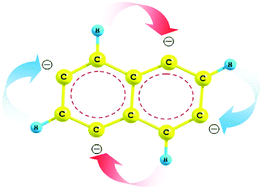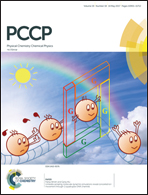Chemical pathways for poly-anionic isomerisation in the metastable anions of tetra-deprotonated naphthalene: an intra-molecular inter-ring proton-transfer†
Abstract
A surprising chemical pathway involving an intra-molecular proton-transfer between the two different aromatic rings of naphthalene is revealed while exploring the isomerisation in the metastable tetra-anionic species of tetra-deprotonated naphthalene. The pathways are explored through quantum-mechanical computations employing a global reaction route mapping (GRRM) strategy. Notably, several other pathways traced exhibit interesting aspects of poly-anionic isomerisation in the multiply-charged metastable molecular anions, which can provide valuable insights into the mechanisms of ring closure and expansion leading to species like azulenes, cyclodecapentaene, and phenylvinylacetylene. The metastable poly-anionic species along the pathways were also analysed using a nuclear charge stabilisation procedure while employing conventional density functional theory (DFT) with the B3LYP exchange–correlation functional as well as long-range and dispersion corrected DFT/ωB97XD and DFT-D3 methods. Interestingly, the charge stabilisation method using the DFT/B3LYP was found to be more reliable than the dispersion corrected methods.



 Please wait while we load your content...
Please wait while we load your content...